The post SAWTEE Steps-up for Nepal’s Sustainable Development appeared first on Nepali Sansar.
]]>The new center envisages to promote sustainable development and inclusive development across Nepal.
The Center considers overall economic transformation in line with SDG principles as a key focus area of operations towards Nepal’s development, says former UN Under-Secretary-General Gyan Chandra Acharya, who will be heading the SAWTEE Nepal.
Meanwhile, SAWTEE Chairman Posh Raj Pandey said the Center will bring together policies, politics and expertise engaging all the related stakeholders in their scientific and non-partisan research process.
Nepal SDGs
In his inaugural address, Nepal Minister for Foreign Affairs Pradeep Gyawali informed that Nepal has already begun adopting SDGs at the policy-level and is currently working towards integrating them at gross-root levels of the country.
Gyawali feels that SDG implementation across local levels will help in engaging domestic and international stakeholders in the development process.
Meanwhile, former Foreign Minister Prakash Saran Mahat opined that rule-based implementation of these rights and procedures pertaining to sustainable and inclusive development is key for development.
With private sector leading the growth, the government should continue holding equitable distribution across the development chain, added Mahat.
How SAWTEE Works?
In collaboration with the government, the Center aims to be a catalyst in Nepal’s developmental process through a research, analysis, advocacy and dialogue methodology.
“The activities of the Center will contribute not only to existing issues and policies, but will also provide alternate ideas to decision makers,” says SAWTEE Chairman.
According to a press release, the Center will majorly focus on: job creation, structural transformation, gender mainstreaming, sustainability, global partnership, and establishing an integrated, holistic & multi-stakeholder approach.
The Center’s activities will include politicians, experts, civil servants, private players, academia, among others.
Overall, SAWTEE’s Nepal aims to develop a well-planned national strategy for a full-fledged transformation of Nepali economy with support of the country’s existing federal, democratic and republican structure.
The post SAWTEE Steps-up for Nepal’s Sustainable Development appeared first on Nepali Sansar.
]]>The post Tech-savvy Nepal: Internet and Tech Adoption Upward Trends in Nepal appeared first on Nepali Sansar.
]]>Here is an interesting coverage that takes you through the country’s range of advancements in the recent times and in fact, introduces a new Tech-savvy Nepal!
Internet revolution has brought in a lot of transformation across the world and Nepal is no exception in catching up the trend. Driven by mobile and technology revolution, the number of internet users in the country is on a growth trajectory and progressing at a pace to make Nepal a tech-savvy country.
Trend Over the Years
A Nepal Telecommunication Authority (NTA) report, released in October 2017, positions the total number of internet users in Nepal at 16.67 million as of 2017, nearly 63% of the country’s overall population.
Surprisingly, 2017 alone saw the addition of 2.25 million new users with more than 250 users joining the internet community every hour, which is a staggering 15.60 percent rise year-on-year.
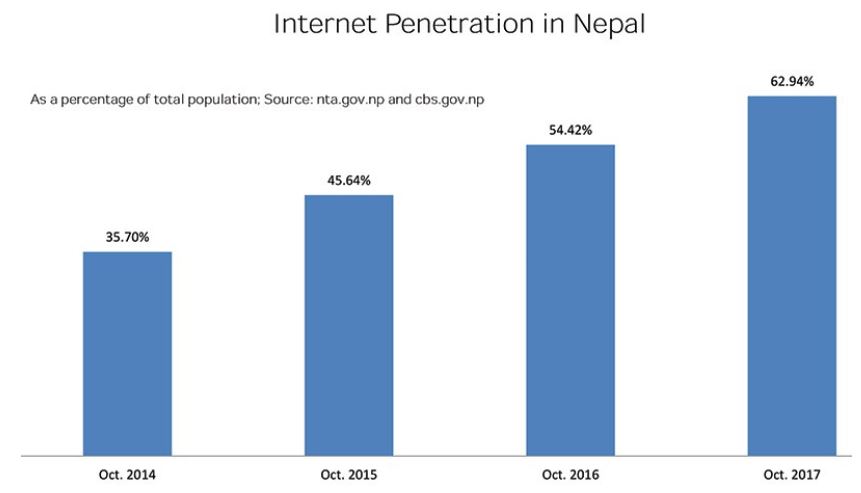
(Source: NTA)
Year-wise trend shows the rise in Nepal’s internet penetration from 35.7 percent in 2010 to 45.64 percent in 2015 and 54.42 percent in 2016 to a new high of 62.94 percent in 2017.
According to NTA, around 95.62 percent of Nepali population are living in the accessible range of mobile towers.
What Drove the Demand?
According to the local service providers, the number of internet users in Nepal has been growing gradually over the years, majorly driven by mobile revolution.
The providers attribute this mobile usage trend to the gradual adoption of social media channels such as Facebook and Twitter, and mobile chat applications like Viber, WhatsApp, among others by Nepali youth and other sections of the society.
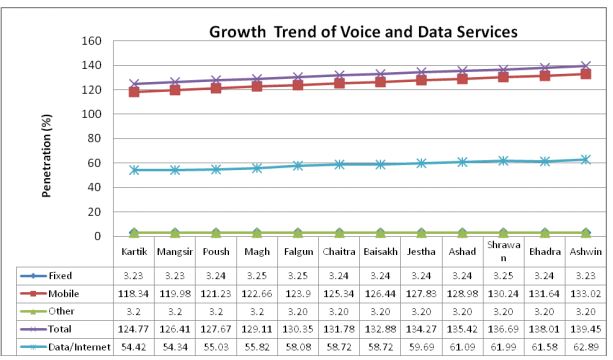
(Source: NTA)
International voice and video calling are also among the key catching-up trends in Nepal.
“The launch of 4G service also helped increase the number of new internet users last year,” says Purushottam Khanal, Senior Director at NTA. Khanal feels that the growth can reach new heights if the network connectivity reaches its full potential across all parts of the country that lag communication infrastructure.
The emergence of a wide variety of start-up companies is also contributing to the rise in internet user-base.
With 2G and 3G services existing since long, 4G services came into effect since 2017 with major providers offering the same across various cities of the country. So far, Ncell stands top in 4G services catering to users across 21 cities across the country.
Other technologies such as FTTH, ADSL, WiMAX and Co-axial cables are among other technologies being used for fixed internet services, and various private ISPs are keen on market expansion.
State-owned Provider Leads
Out of the country’s wide range of network service providers, the state-owned Nepal Telecom (NT) is leading the race with the largest customer base of 8.66 million users for mobile-based internet services on a variety of technology platforms such as GPRS, EDGE and WCDMA.
NT alone represents 54.91 percent of the Nepali mobile-based internet market share followed by Ncell holding 7.41 million users with 42.43 percent share, among others.
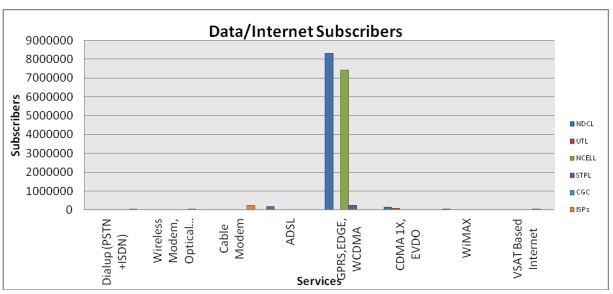
(Source: NTA)
Apart from telecom providers, at least 23 Internet Service Providers (ISPs) are also offering internet services through cable and fiber networks, catering to 322,433 user-base i.e., around 1.93 percent of the total internet users of the country.
Owing to their unlimited options, the adoption of cable networks is largely observed across offices in the country.
The Ultimate Goal
It was way back in 1993 that Nepali society saw internet services which eventually drew a wide attention across all walks of life in the country.
Further, the country started witnessing the emergence of cyber cafes and further smart phone evolution that expanded internet services in Nepal to the next level, making them integral part of life.
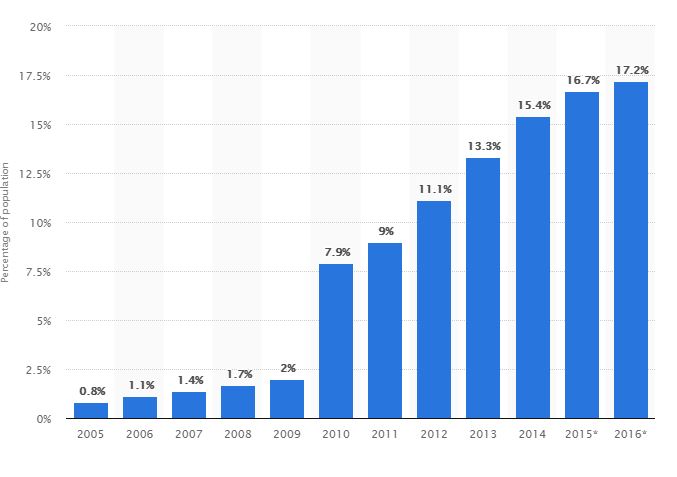
(Source: NTA)
Expansion of services and growing demand gave needed boost and made internet services, technology and related products affordable to the Nepali society.
As a connectivity expansion move, NT had also announced setting up of 500 Wi-Fi hotspots in 2010 across major cities including Kathmandu.
However, there are also concerns with regard to poor connectivity across rural areas of the country and there do exists a debate that internet services in Nepal remain urban-centric.
“The scenario of internet penetration throughout the country is grim. Every household should have internet connectivity in order to achieve tangible development goals, which is the last-mile technology,” says Binay Bohra, President of Internet Service Providers Association of Nepal (ISPAN).
“We’ve been issuing licenses to rural ISPs so that every nook and cranny gets Internet connectivity,” says Ghimire, Deputy Director, Consumer & Economic Analysis Section of Nepal Telecommunications Authority (NTA).
The post Tech-savvy Nepal: Internet and Tech Adoption Upward Trends in Nepal appeared first on Nepali Sansar.
]]>The post SDGs: Public Sector to Play Vital in Nepal’s Sustainable Development appeared first on Nepali Sansar.
]]>Out of the required annual investment of USD 17 billion, public sector is expected to hold a major share of 51 percent leaving 21 percent contribution to the private sector and the remaining share to NGOs, households and cooperatives.
Majority of the public investment is expected to be allocated to poverty alleviation, agriculture, health, climate change, water and sanitation, education, transport infrastructure and governance.
Meanwhile, the private sector investment will be made for industry development, physical infrastructure, housing, urban infrastructure, tourism and energy sectors.
“But, the government’s revenue and private sector investment will not be sufficient to attain SDGs by 2030, requiring huge amount of foreign aid,” noted the report.
SDGs, a follow-up to the Millennium Development Goals (MDGs) that expired in 2015, include a set of 17 goals and 169 targets involving a broad range of development issues such as fighting poverty and hunger, health coverage, gender equality, quality education, and all aspects of inclusive and sustainable development.
SDGs Status As of 2017
NPC’s National Sustainable Development Review Report 2017 reported significant progress in few of the country’s SDGS up to June 2017.
Poverty (SDG 1): The percentage of Nepali citizens below poverty line has declined from 38 percent in 2000 to 21.6 percent in 2015.
Hunger and Nutrition (SDG 2): NPC reported Nepal’s significant progress in reducing hunger, achieving food security and improving nutrition. Proportion of underweight children, prevalence of stunted children, among other relevant indicators have registered a decline over the last 10 years.
Health and Wellbeing (SDG 3): Nepal has also seen a significant progress in addressing health concerns among its populace. The country achieved a gradual progress in controlling infant mortality rate (64/1000 live births in 2000 to 32 in 2016), number of pregnant women going for antenatal checkups by skilled workforce, proportion of births in health facilities, among others.
Gender Equality (SDG 4): Nepal saw a notable development in terms of ensuring gender equality and women empowerment. A significant improvement in gender parity can be observed across the education institutions, among other areas across the country.
Inclusive Industrialization (SDG 5): Infrastructure development has seen a significant traction in Nepal over the past few years, which is evident in country’s road, rail, air, tourism, communication, industry infrastructure facilities.
Means of Implementation (SDG 17): The report noted a concern in the availability of resources to finance the achievement of SDGs. Highlighting the role of adequate finance, technology, institutions, capacity and partnership vital for SDGs, the report also indicated a positive growth in terms of partnerships among private players, cooperatives, civil society, development partners and the international community for achieving sustainable development.
Need of the Hour
Towards addressing the existing concerns and achieve SDGs, NPC suggests the country to have strong governance across federal, provincial and local levels.
The Planning Commission also suggests macroeconomic policy reforms for economic growth and bringing in a balance among the poor and marginalized communities.
Pitching on the need for effective management of resources needed for achieving SDGs, the Commission suggests the government to prioritize interventions based on fiscal, financial, managerial, technological, institutional and other capacity constraints.
NPC also suggests the Government of Nepal to design sectoral plans and long-term strategies in line with SDGs, and also integrate SDGs across all levels of Nepali society.
The post SDGs: Public Sector to Play Vital in Nepal’s Sustainable Development appeared first on Nepali Sansar.
]]>The post UNDP Program to Benefit 14,000 Nepali Farmers appeared first on Nepali Sansar.
]]>The initiative, a joint implementation of the United Nations Development Program (UNDP) and the Government of Nepal, aims to come up with innovative solutions to ensure fair market opportunities for the country’s farming community and their agricultural produce.
CMDP is expected to form a strong base for an effective market chain for Nepal’s agricultural produce including thus enhancing farmer income and their living.
“The active engagement and financing from the Ministry of Cooperatives and Poverty Alleviation shows strong commitment, leadership and ownership of the program. This partnership will directly benefit thousands of Nepali farmers over the next five years, through crucial support in modernizing their production and market chain,” says Renaud Meyer, Country Director, UNDP Nepal.
The program will focus on six districts near Kathmandu area owing to the prevalence of poor infrastructure, improper storage and transport facilities, inadequate market access and regulatory concerns issues.
This situation prevails despite a good number of farmers’ cooperative groups in the area.
Supporting UN Goals
Besides supporting market infrastructure, the program also aims at quality and quantity enhancement, while also ensuring consistency in supply of the agricultural produce.
As part of skill development, the initiative also focuses on training farmers on better techniques, building their marketing and institutional capacities.
Overall, the initiative is expected to benefit around 14,000 farmers and their families, thus also supplementing to the South Asian country’s implementation of UN Sustainable Development Goals (SDGs) 1 and 2 on fighting poverty and achieving food security.
The post UNDP Program to Benefit 14,000 Nepali Farmers appeared first on Nepali Sansar.
]]>The post Dr Ek Raj Ojha appeared first on Nepali Sansar.
]]>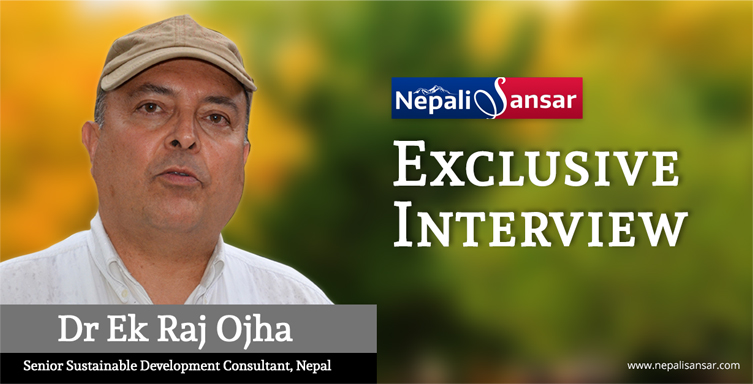
Interview by Sai Nikesh D
Nepal has come a long way in development. As a nation sharing borders with the world’s two major economies, Nepal has been striving to become a developing country and grow further to achieve the developed country status. As a process, the Government of Nepal has been actively participating in various global and local level platforms promoting country’s strengths and potential to development, and is sincerely aiming to see the benefits as part of its UN 2030 Agenda.
Continuing with a wide coverage on Nepal and its developments over a period, Nepali Sansar, as a Nepal-focused media house, got a chance to get in touch with Dr.Ek Raj Ojha, Senior Sustainable Development Consultant from Nepal, for a better understanding of the country’s progress towards its set goals.
Dr. Ojha, with his sound expertise in working with national and international level organizations like ADB, UN and government departments in sustainable development and planning, policy framework, among other key aspects of development and planning, shared a valuable information in this regard, helping us portray a complete picture of Nepal and its developmental path over a period and towards future.
Following are a few excerpts of Nepali Sansar Bureau’s detailed interaction with Dr. Ojha:
The post Dr Ek Raj Ojha appeared first on Nepali Sansar.
]]>The post Nepal Finds Pride in Successful Horn Ban Policy appeared first on Nepali Sansar.
]]>While Kathmandu was ranked fifth in the Global Pollution Index 2017 mid-year survey, the continuous efforts of Kathmandu Metropolitan Traffic Police (KMTP) to ban honking in the city’s traffic turned positive for the country’s development portfolio on a global level.
KMTP’s regulations over sounding of horns in traffic, through fine collection beginning from April 2017, not only transformed Kathmandu into a horn-free city, but also proved the country’s strength in public-policy collaboration.
“In all of South Asia, this is one of the most successful initiatives by the traffic police. This is our pride,” says Madhu Sudan Silwal, a senior police officer who spent most of his time regulating traffic on Kathmandu’s roads as part of duty.
Elated at the transformation, Mingmar Lama, the Chief of KMTP when the horn ban initiative was introduced, says, “I wanted drivers in Kathmandu Valley to be civilized. Now if you blow the horn, people will look at you, just like in a developed country, as if you were uncivilized.”
The ban was first rolled out in Kathmandu in April 2017 marking the start of new Nepali year, and is currently being tested across other cities of the country.
If everything goes as planned, the authorities expect Nepal to become horn-free very soon.
As a country with the least-developed status, Nepal has been striving at its best to prove on a global scale, and the horn ban policy appears as an opportunity for the country.
The Kathmandu Traffic Police feel the horn ban policy is a mark of Nepali society’s sophistication.
“Now all the foreigners feel Nepal’s people are good,” says Sarbendra Khanal, the current Chief of Kathmandu Traffic Police.
The post Nepal Finds Pride in Successful Horn Ban Policy appeared first on Nepali Sansar.
]]>The post UNDP: Public-private Partnership for Nepal’s SDGs Discussed appeared first on Nepali Sansar.
]]>The program, organized in collaboration with the Embassy of Republic of Korea (RoK) in Nepal, witnessed the participation of various representatives from the concerned organizations.
Speaking on the theme, “Role of private sector for sustainable development”, the representatives stressed on the need for public-private partnership for achieving SDG goals of Nepal.
Global Compact Nepal Vice-Chair Pradeep Vaidya called for public-private partnership for progress in Nepal’s SDG targets.
Highlighting the role of private sector, the representatives called for the creation of investment-friendly environment for the private sector to contribute to the country’s efforts to alleviate poverty.
While stating that Nepal holds good potential in various sectors such as agriculture, among others, the participants urged on the need for drawing foreign investment in Nepal.
In his address at the program, the National Planning Commission Vice-Chair Dr Swarnim Wagle informed that the local governmental policies and regulations are also in line with the Nepal’s UNSDG goals.
“Nepal has witnessed significant improvements in the areas of health and education in the recent years and the government is doing a role of facilitator to promote domestic and foreign investment in big projects,” he added.
Meanwhile, the Secretary at the Ministry of Industry Yam Kumari Khatiwada informed that the government has created a friendly environment to ensure skill development and employment at home.
RoK’s Ambassador for Nepal Park Young-Sik felt agriculture, tourism and hydropower sectors are key for Nepal’s SDGs.
UNDP Resident Representative in Nepal Valerie Julliand called for special focus on economic growth for attaining SDG goals.
The post UNDP: Public-private Partnership for Nepal’s SDGs Discussed appeared first on Nepali Sansar.
]]>The post World Bank Cautions Nepal on Its Federal Government System appeared first on Nepali Sansar.
]]>“As Nepal prepares for an ambitious shift from a unitary to a federal system of government, closer attention to sequencing political, financial and administrative decentralization will be key,” stated the World Bank in its latest report titled ‘Nepal Development Update’, released on September 17, 2017.
It further said that the country’s new fiscal federalism system is suggesting marked asymmetry between stronger decentralization of spending responsibilities and relatively unchanged low decentralization of tax collection powers. “Similar imbalances hold true between regions across the country,” it added.
According to the World Bank, a large proportion of Nepal’s federal spending would likely be passed on to subnational governments starting from FY 2018. It says such a move would lead to increased public spending in the country.
Commenting on the case, Takuya Kamata, the World Bank’s Country Manager for Nepal said, “The subnational governments will play an increasingly critical role in Nepal’s public expenditures. A system of fiscal transfers that is designed for transparency and predictability and supported by a small set of simple rules could go a long way in helping meet the development objectives of federal Nepal.”
On the other side, the World Bank also cautions that unaddressed issues in the new federal system might challenge the budget execution, especially in the coming fiscal year.
According to the report, recent floods in mid-August have largely impacted the rebounding economic growth of Nepal.

Budget Expenditure, a Perennial Problem in Nepal: World Bank
The latest update pointed at the issues related to Nepal Government’s budget planning.
“More than 60 percent of the capital budget was spent in the last quarter of the fiscal year, while expenditure remained significantly below the planned budget, a perennial problem in Nepal. The era of balanced budgets has ended with the fiscal deficit reaching an estimated 3.3 percent of GDP in FY 2017 and expected to increase going forward as well,” the Nepal Development Update said.
With regard to trade, the report noted that the country’s import growth remains strong, while exports and remittances are expected to remain sluggish.
The World Bank releases the Nepal Development Update twice in a year with a prime focus on the country’s economic development over the preceding months, placing them in a longer-term and global perspective.
This report is for the business community, policymakers, analysts and professionals engaging in economic debates related to the country and the public.
The post World Bank Cautions Nepal on Its Federal Government System appeared first on Nepali Sansar.
]]>